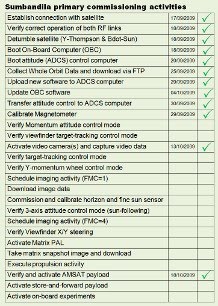We have for the first time activated the S-band data transmitter on the satellite and captured the transmitter-generated test pattern at the Overberg Test Range (OTB) station near Bredasdorp. During this exercise the satellite was in a target-tracking control mode, with the S-band waveguide antenna "tracking" the OTB station.
The image below shows the captured test pattern.

SunSpace was established in 2000 as a spin-off from Stellenbosch University following the successful launch of SUNSAT by NASA with a Delta-II launch vehicle. During the past decade SunSpace has developed and delivered numerous satellite components, subsystems and two flight model satellite, now operational in space. This blog documents the mission of Sumbandila (funded by the DST), launched on a Soyuz-2.1b on 17 September 2009. SunSpace places a high premium on a strong partnership with the South African Government for supplying the ongoing satellite needs of our government.
06 November 2009
Fine Sun Sensor calibrated
Below is an image taken by the Fine Sun Sensor before calibration (right) and after the sensor output levels have been calibrated (left)
05 November 2009
Three-axis stabilized
The satellite is now in a full three-axis control mode, using the three orthogonally placed reaction wheels, data from the calibrated fine sun sensor and the fiber-optic gyroscopes. This is a major step in the direction of taking the first images with the main payload camera.
03 November 2009
SA-AMSAT payload status
For those interested in the progress made on the SA-AMSAT payload commissioning, please visit / join the Google Group that was specifically established for this purpose (follow link at the bottom of the right-hand column on this page). The discussions on this group are of a more technical nature. The required CTCSS tone to activate the transponder has for instance been published on this group.
During the commissioning of Sumbandila we try to work in the scheduling of the SA-AMSAT payload as often as we can, but the service can by no means be guaranteed at this stage. The commissioning of the satellite is expected to last more or less six months (from date of launch), during which time our primary focus is on demonstrating success with the high-resolution imager - the main payload on the satellite.
The activation schedule for the SA-AMSAT payload will be published on the AMSAT-BB, in addition to being visible on the Google Group, as and when our satellite commissioning schedule permits activation.
We appreciate the eager participation of all Hams worldwide, and would like to encourage making your feedback visible on the Google Group.
During the commissioning of Sumbandila we try to work in the scheduling of the SA-AMSAT payload as often as we can, but the service can by no means be guaranteed at this stage. The commissioning of the satellite is expected to last more or less six months (from date of launch), during which time our primary focus is on demonstrating success with the high-resolution imager - the main payload on the satellite.
The activation schedule for the SA-AMSAT payload will be published on the AMSAT-BB, in addition to being visible on the Google Group, as and when our satellite commissioning schedule permits activation.
We appreciate the eager participation of all Hams worldwide, and would like to encourage making your feedback visible on the Google Group.
ADCS code updated
We have completed a major Attitude Determination and Control System (ADCS) software code upload to the satellite. As a result the satellite is once again in a Nadir-pointing attitude.
In addition, we continued with periodic scheduling of the SA-AMSAT payload and recently had contacts through the satellite from the USA and Australia.
We are now working towards obtaining the first high-resolution images from the on-board linescan and matrix detectors.
In addition, we continued with periodic scheduling of the SA-AMSAT payload and recently had contacts through the satellite from the USA and Australia.
We are now working towards obtaining the first high-resolution images from the on-board linescan and matrix detectors.
Subscribe to:
Comments (Atom)
Current Keplerian Elements
Last Update: 1 Febr 2010
Element set: 404
Sumbandila 1 35870U 09049F 10032.48635300 .00000433 00000-0 21444-4 0 4040 2 35870 097.3525 084.8560 0011505 166.1189 300.7196 15.22856092 20818

